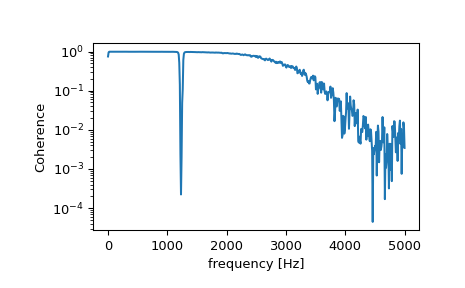scipy.signal.coherence#
- scipy.signal.coherence(x, y, fs=1.0, window='hann', nperseg=None, noverlap=None, nfft=None, detrend='constant', axis=- 1)[source]#
Estimate the magnitude squared coherence estimate, Cxy, of discrete-time signals X and Y using Welch’s method.
Cxy = abs(Pxy)**2/(Pxx*Pyy), where Pxx and Pyy are power spectral density estimates of X and Y, and Pxy is the cross spectral density estimate of X and Y.- Parameters
- xarray_like
Time series of measurement values
- yarray_like
Time series of measurement values
- fsfloat, optional
Sampling frequency of the x and y time series. Defaults to 1.0.
- windowstr or tuple or array_like, optional
Desired window to use. If window is a string or tuple, it is passed to
get_windowto generate the window values, which are DFT-even by default. Seeget_windowfor a list of windows and required parameters. If window is array_like it will be used directly as the window and its length must be nperseg. Defaults to a Hann window.- npersegint, optional
Length of each segment. Defaults to None, but if window is str or tuple, is set to 256, and if window is array_like, is set to the length of the window.
- noverlap: int, optional
Number of points to overlap between segments. If None,
noverlap = nperseg // 2. Defaults to None.- nfftint, optional
Length of the FFT used, if a zero padded FFT is desired. If None, the FFT length is nperseg. Defaults to None.
- detrendstr or function or False, optional
Specifies how to detrend each segment. If
detrendis a string, it is passed as the type argument to thedetrendfunction. If it is a function, it takes a segment and returns a detrended segment. Ifdetrendis False, no detrending is done. Defaults to ‘constant’.- axisint, optional
Axis along which the coherence is computed for both inputs; the default is over the last axis (i.e.
axis=-1).
- Returns
- fndarray
Array of sample frequencies.
- Cxyndarray
Magnitude squared coherence of x and y.
See also
periodogramSimple, optionally modified periodogram
lombscargleLomb-Scargle periodogram for unevenly sampled data
welchPower spectral density by Welch’s method.
csdCross spectral density by Welch’s method.
Notes
An appropriate amount of overlap will depend on the choice of window and on your requirements. For the default Hann window an overlap of 50% is a reasonable trade off between accurately estimating the signal power, while not over counting any of the data. Narrower windows may require a larger overlap.
New in version 0.16.0.
References
- 1
P. Welch, “The use of the fast Fourier transform for the estimation of power spectra: A method based on time averaging over short, modified periodograms”, IEEE Trans. Audio Electroacoust. vol. 15, pp. 70-73, 1967.
- 2
Stoica, Petre, and Randolph Moses, “Spectral Analysis of Signals” Prentice Hall, 2005
Examples
>>> from scipy import signal >>> import matplotlib.pyplot as plt >>> rng = np.random.default_rng()
Generate two test signals with some common features.
>>> fs = 10e3 >>> N = 1e5 >>> amp = 20 >>> freq = 1234.0 >>> noise_power = 0.001 * fs / 2 >>> time = np.arange(N) / fs >>> b, a = signal.butter(2, 0.25, 'low') >>> x = rng.normal(scale=np.sqrt(noise_power), size=time.shape) >>> y = signal.lfilter(b, a, x) >>> x += amp*np.sin(2*np.pi*freq*time) >>> y += rng.normal(scale=0.1*np.sqrt(noise_power), size=time.shape)
Compute and plot the coherence.
>>> f, Cxy = signal.coherence(x, y, fs, nperseg=1024) >>> plt.semilogy(f, Cxy) >>> plt.xlabel('frequency [Hz]') >>> plt.ylabel('Coherence') >>> plt.show()
